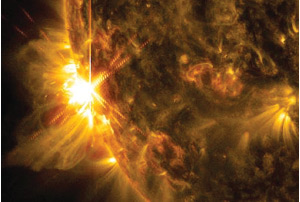NASA captures the sun's powerful solar flares
NASA has captured dramatic images of the sun as it emitted three
X-class solar flares, the second of which occurred just an hour after
the first.
|

An X2.2 flare solar flare bursts off the left limb of the sun in
this image captured by NASA's Solar Dynamics Observatory on June
10, 2014, at 7:41 a.m. |
NASA's Solar Dynamics Observatory observed the sun as a significant
solar flare burst from its left side, peaking at 7.42 am on June 10. The
sun then released a second X-class flare which peaked just over an hour
later at 8.52 am.
The third, classified as an X1.0, erupted Thursday and peaked at 5:06
am. EDT. NASA explains that solar flares are the most powerful bursts of
radiation that cannot pass through Earth's atmosphere to physically
affect humans on the ground.
However, the flares can disturb the Earth's atmosphere in the layer
where GPS and communications signals travel. The second X-class flare of
June 10, 2014, appears as a bright flash of the image from NASA's Solar
Dynamics Observatory (NASA/SDO). Tuesday's flares, which measured X2.2
and X1.5, were reportedly powerful enough to temporarily interfere with
radio communications in Europe.
Dr Dan Brown, an astronomy expert at Nottingham Trent University,
said the flares can create a radio blackout event classed as "R3" which
are common during the sun's activity cycle.
Michael Lockwood, a Professor of Space Environment Physics at the
University of Reading, said any interference would have been
short-lived.
He said: "You do get radio noise from solar flares and if you can see
the actual flare then you will pick up radio noise. It can affect radar
communications systems, but it is quite a brief pulse.
These images are from NASA's Solar Dynamics Observatory and show
light in a blend of two ultraviolet wavelengths: 171 and 131 angstroms.
The former is colourised in yellow; the latter, in red.
"More significant is if there is an associated coronal mass ejection
(CME) - very large amounts of material being blown out of atmosphere
into space. From the position of this, it won't be directed towards us -
they have to be much nearer to the centre of the visible disc of the sun
to hit us."
- The Independent
|

